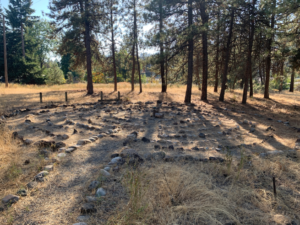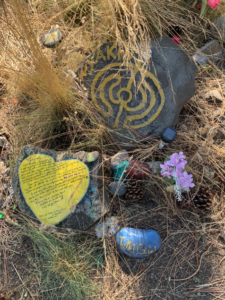Sunday, February 13, 2022
Around 5 a.m., I woke to Kya Anne rolling with enthusiasm – the blow (storm) Paul had mentioned on Thursday had arrived. Originally, it was scheduled to come in late Sunday, early Monday, but she rolled in early, complete with winds up to 40 knots, lightning and rain.
Repeatedly, I heard the radio squawk to life “Double D, Double D, Double D, this is the Freedom. You’re dragging, and you’re getting awfully close.” The Double D was nonresponsive, possibly because they were still asleep since it was so early. “Dragging” means they were no longer securely anchored. Consequently, the Double D were drifting in the direction of the S/V Freedom, and the Freedom was concerned about the possibility of a collision. I was up and out of my berth, looking through the portholes (windows), seeing lighting flash in the darkness, but little else. I remember passing the

When I boarded a few days earlier, Paul had run me through how to make an emergency radio call again and what to do in the event of an emergency.
Start by repeating your status* (*Securite, Pan-pan or Mayday), followed by your call sign (also repeated three times, announce the vessel (This is the Kya Anne (also three times), give your location three times (latitude & longitude), followed by your message.
This current squall is expected to run a couple/few hours with a break before the next.
The USCG periodically announced that the NWS (National Weather Services) had issued a storm alert for hazardous weather, so I pulled up the website for a quick overview of what to expect
This Hazardous Weather Outlook is for the Florida Keys and adjacent coastal waters.


DAY ONE…TODAY AND TONIGHT
Isolated thunderstorms will be possible today. The primary thunderstorm hazard will be cloud to surface lightning strikes.
A Small Craft Advisory will be required beginning tonight for all Keys waters due to the passage of a cold front bringing fresh to strong northerly breezes and fast building seas.
DAYS TWO THROUGH SEVEN…MONDAY THROUGH SATURDAY
A Small Craft Advisory will likely be required for portions of Keys waters from Monday through Thursday due to fresh to strong northerly breezes that will steadily clock northeast then east.
8:23 am
the United States Coast Guard (USCG) came online with a Pan-Pan alert, announcing an EPIRB (Emergency Position Indicating Radio Beacon) had gone off in the vicinity of the Key West Moran field and asking all mariners to be on the lookout. At the same time, the Double D came motoring around us and we couldn’t determine what he was trying to do. We eventually realized he was just motoring around- possibly because he either lost his anchor or just couldn’t find good anchorage and decided it was best to just keep moving for the time being, rather than letting the ocean determine its direction.
A few minutes later, another boat came online, indicating that a white S/V at marker 29 was dragging…
The morning was full of those types of radio calls.
9:02 a.m.
I could only hear the Coast Guard (CG) side of a conversation. A vessel had called in to the Coast Guard, indicating they had run aground. The CG was asking vessel details, number of people onboard (adults & children), if everyone had Personal Flotation Devices (PFDs) and was wearing them, is the vessel taking on any water, are there any medical concerns? What is the GPS location?
Meanwhile, Paul pointed out a small skiff, motoring out, and wondered out loud what in the world would cause someone to be out in these conditions?

9:10 a.m.
A vessel hails the USCG for an unresponsive boat that was dragging and on a collision course with them. The USCG sends out a boat to check on the dragging boat and its occupants.
9:35 a.m.
USCG comes on the radio, advising mariners that a channel marker down by Duck Key had been destroyed and warning mariners to be extra alert in that vicinity.
Now, I’m not a sailor and I’m only a few days into my sailing experience, so my thoughts and observations are (obviously) from someone with virtually no knowledge and skills, but here are some of the things I’ve learned so far:


- Keep your VHF on—how can you be alerted to hazards if your radio is off? Despite the calm in their voice, I could also hear frustration from captains trying to hail unresponsive vessels.
- Always identify your own vessel and the one you are trying to hail. Sometimes, especially in stormy conditions, you can’t identify the name of a vessel. In those instances, I heard them giving colors of the hull, sails, pilot houses, etc. of the boat they were trying to hail. For others on the water, its helpful to clearly identify your vessel as well, so others nearby can keep their eyes alert and be aware of the proximity of the issues you are trying to address.
The next few days on the water will ensure that I have a chance to do some writing, maybe win a few card games, and definitely pepper Paul with questions so I can benefit from his years of experience and wisdom.

Boating Basics of VHF Channel 16:
VHF Channel 16 is the international distress frequency that is received on a VHF frequency worldwide. It broadcasts on a frequency of 156.8 MHz and is used for distress and emergency calls as well as for informational broadcasts from the Coast Guard. All broadcasts should start with your status, repeated three times.
Securite, Securite, Securite: non-emergency signal, generally used for alerts; an informational broadcast
Pan-pan, pan-pan, pan-pan: for non life threatening situations that could escalate into a mayday situation; an international signal of urgency used when the safety of a person or the boat is in serious jeopardy but not immediate danger
Mayday, Mayday, Mayday: for life threatening situations, Mayday is the internationally recognized distress call that is used only in situations in which there is an immediate danger of vessel or loss of life.
Repeat each piece of information slowly and clearly three times before moving on to the next piece of information.
Example:
“MAYDAY, MAYDAY, MAYDAY. This is the sailing vessel Kya Anne, Kya Anne, Kya Anne.
My location is 24 degrees 34.15 minutes north, 81 degrees 48.22 minutes west.
24 degrees 34.15 minutes north, 81 degrees 48.22 minutes west.
24 degrees 34.15 minutes north, 81 degrees 48.22 minutes west.
I have an adult female who has collapsed and is breathing irregularly. I need medical assistance immediately. I am a white 40-foot catamaran with two people on board. OVER”
DISCLAIMER: Ya’ll, I am not skilled or trained or proficient in the world of boating and sailing. This is just me sharing what I have learned- and I may have heard or learned something incorrectly, so don’t take this as gospel. Do the research, get some training and talk to a professional. Do not rely on information provided by this novice (who had a cocktail (or two)) while writing this.





